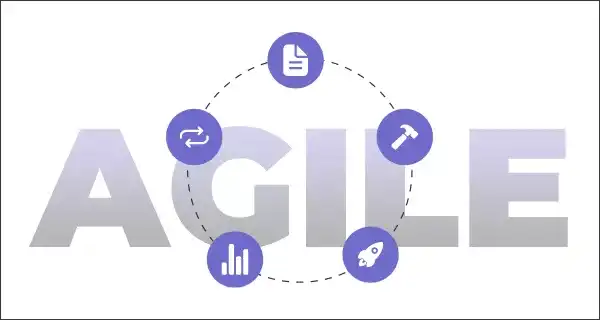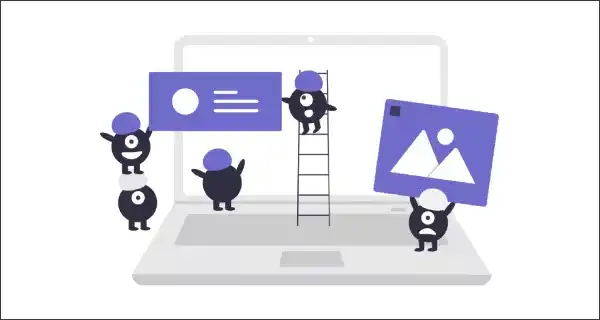Successful software development depends on a team that is adaptable, willing to respond promptly, and the one that won’t bat an eyelid to the client’s overnight demands. This is precisely what an Agile development team looks like.
The innovative methods of Agile have taken over the world of software development by storm. Forward-thinking businesses and software developers use Agile methodology for successful project deliveries.
According to Harvard Business Review, 60 percent of companies experience an increase in revenue and profits after using an Agile approach.
But, should you hire an Agile software development team for your next project?
In this article, we will discuss everything agile – what agile is all about, how it differs from the other models, its core principles and features, and the best practices to be successful with Agile.
What is Agile Software Development Based on?
Agile software development is a practice that is based on the continuous iteration of development and testing.
It is one of the simplest but effective processes to transform a business vision into a software solution. It encourages flexible responses to change.
In fact, Agile is a mindset that promotes transparency and adaptation. It involves software development best practices such as team collaboration, continual planning, continual learning, improvement, development, and early but incremental delivery.
Agile emphasizes keeping the software development cycles short, process lean, and building a Minimum Viable Product (MVP) that goes through many iterations to become the final product.

Is Agile Same As Waterfall Model?
No, Agile and Waterfall are two different models.
When you begin a software development project, you will have to deal with this question.
All software development projects follow a specific SDLC (Software Development Life Cycle) with a clearly defined methodology. It helps business owners ensure their end product is developed with the highest quality code.
Agile and Waterfall are two popular but different methodologies, and the right approach will always depend on the scope of your project.
What is the Agile Software Development Approach?
Agile is a type of software development approach that is mainly used when requirements and solutions evolve with the collaborative effort of cross-functional teams and customers.
It is gaining popularity in different industries because of its flexibility, adaptiveness, focus on improvement, and high-quality results. This approach is built as a response to the shortfalls of the Waterfall approach.
What is A Waterfall Model?
The waterfall is a traditional project management methodology. It is a linear design approach where progress flows downwards in a single direction — like a waterfall.
It is built with the belief that moving to the next phase of software development can only happen after the current phase is completed.
Every phase of Waterfall occurs in the following order:
Let’s dig deeper into this section and find out how both are different and which method will work better for you.
| \\\*\\\*AGILE\\\*\\\* | \\\*\\\*WATERFALL\\\*\\\* | |
| Life Cycle and Approach | It follows an iterative and incremental approach towards software development. | Its lifecycle is linear and sequential – just like a waterfall. |
| Level of Flexibility | It is a highly flexible and continuously evolving way of building software. | Its process structures are a lot stringent and rigid for software development. |
| Project division | The project is divided into time-boxed phases called sprints. | The project is divided into phases. |
| Software development projects | It helps complete software development as a collection of multiple small projects. | It helps complete one single project at a time. |
| Mindset | It follows a product mindset, with an emphasis on customer satisfaction. | Follows a project mindset with a focus on successful project delivery. |
| Project requirements | Can be prepared anytime during the project. | Must be prepared at the start of the project only. |
| Alterations in scope | It allows scope alteration at any time in the project, even after the planning. | It completely avoids any scope change after the project starts. |
| Testing | Done concurrently with development. | It is done only after the building phase. |
| Participation of test teams in requirement change | Can participate. | Cannot participate. |
| Need of a dedicated project manager | No | Yes |
| When to use | It is an ideal solution for projects demanding recurrent requirement changes. | Works well for projects that have fixed requirements. |
Things to Know about the Agile Software Development Approach
Agile is a process that will help your development partner provide fast responses to any feedback on your project.
It creates opportunities to assess your project’s direction during its development cycle. And, all of this is done in regular project meetings called sprints or iterations.
So here’s what you must know about Agile development.

1. Agile Principles
Agile follows a set of principles to improve the process of software development and project management.
- Customer satisfaction: A happy and satisfied customer with the help of early and continuous product delivery is the highest priority of the Agile approach.
- Welcome requirements change: Agile handles the project’s changing requirements, even if they are introduced late during the development.
- Work in collaboration: All business units and the developers work together regularly throughout the project lifecycle.
- Deliver frequently: The focus is on the continuous delivery of software in a shorter timescale (ranging from a few weeks to a couple of months).
- Motivated team: The projects thrive with motivated team members. Motivation builds when the team knows they are trusted to get the work done.
- Working software: The primary measure of project progress is evaluated based on working software (product).
- Simplicity: The volume of work not being done should be reduced with the help of simpler processes.
- Good design: Focusing on technological excellence and good design significantly affects the project’s agility.
- Constant pace: The agile process maintains a consistent speed leading to sustainable development.
- Self-organized: Agile and self-organized teams provide the best product architectures, designs, and requirements.
- Reflection and adjustment: The development team becomes more effective by regular self-reflection and adjustment wherever required.
- Now, let’s look at a few of the prominent features of the Agile project management approach.
2. Agile Features
Testing is integrated with the Agile methodology all through its life cycle. There is nothing riskier than postponing all testing until the end of the project. Regular testing enables consistent inspection of the working product as it develops.
It not only allows the customer/product owner to make necessary adjustments while the product is designed, but it also gives the development team early sight of quality issues.
- Transparency
Agile provides the benefit of transparency to the clients. They get a unique opportunity to be involved in all the project stages – right from prioritizing features to planning to review sessions.
- Active Collaboration between Developers and clients
One of the frustrations for clients has always been not monitoring the progress of a project. At the same time, developers get frustrated when a finished project is sent back for multiple revisions.
By collaborating with the client as a partner, modifications are brought in as part of the goal-setting process during product building.
- Short-term Goals over Long-term Plans
The agile methodology encourages breaking projects into smaller pieces. Partners and teams are assigned small chunks of projects with short deadlines. Short-term goals allow better flexibility. As changes arise, plans can be easily modified.
- Iterative Development Cycle
Agile follows an iterative development cycle, where product requirements are refined regularly by breaking down the work into smaller chunks.
- The Inspect and Adapt approach
All internal and external stakeholders frequently review the products and services, and changes are adjusted accordingly.
Although Agile is a popular development model, there are some advantages and disadvantages.
3. Advantages of Choosing the Agile Development Approach
- Highly Adaptable: Agile methodology is highly adaptable because of its incremental and iterative structure. It is well suited to deal with the changes in customer requirements.
- Better Understanding Leads to Better Results: Because it allows consistent client inputs to the project team, it helps develop a better understanding of the client’s needs. Customer input and feedback are not only encouraged at the beginning of the project but throughout the project life cycle.
- Continuous Testing and QA: It promotes continuous and simultaneous testing in the project development life cycle. This makes room for detecting and fixing bugs early on, thus improving the quality of deliverables.
- Enhances Business Value: Since the entire focus of an Agile model is on enhancing the business value, therefore the part of the project that is most important to the client could be developed and delivered first.
4. What are the Disadvantages of Agile?
- Agile does not provide many benefits for small development projects.
- The cost of implementing Agile projects is higher compared to other methodologies.
- The approach lacks an adequately defined structure in comparison to the Waterfall method. So, the project can become challenging at times, requiring a highly skilled team.
- While this method is excellent in theory, it isn’t easy to achieve in practice. It requires total commitment from the right group of people who can work together to deliver successfully.
- Organizations usually do not get it on the first go.
5. When to Use Agile Methodology
So, when should you use Agile for your software development project?
You should go agile when you’re looking for a certain level of flexibility in your project because scaling up is easy with Agile.
Agile provides flexibility in allowing a change in scope at any point in your project. Because of its parallel execution approach, the processes of planning, designing, development, and testing appear many times in the Agile method.
Also, since the customer is involved in every process, Agile promises complete customer satisfaction.
Agile is the go-to methodology for all projects where customer satisfaction is a priority, and the product is transformed repeatedly to evolve as per the changing customer specifications.
Agile promotes human interactions over rigid processes by helping collaborate with clients efficiently, without forcing everyone to stick to predefined arrangements.
Agile Software Development Model: Best Practices

By now, you must have gathered that Agile is more than a mere collection of software development techniques. With an Agile mindset, teams can mix a group of methodologies they like – as long as they stay true to the agile principles of short feedback cycles and continuous process improvement.
Iterations, high quality, adaptation, continuous learning, and trust between teams – these are the core values of an Agile approach.
Read on to check on some agile best practices that can help you deliver high-quality work to your clients.
1. Agile Roles
An Agile methodology in a project involves different roles in a team. The typical Agile roles include the following:
- Team Lead, Project Lead, and Scrum Master
- Team members
- Product Owner for Scrum
- On-site customer for XP
- Stakeholders
Agile teams can also include extended members for technical and domain expertise.
2. Product Vision statement
It is best to begin the project by defining a product vision.
With the initial envisioning for the project, some brief definitions are helpful: scope, the clients, the team composition, a blueprint of the technical approach, and estimated time and cost. It should also include a Vision statement.
3. Business Model Canvas
This tool plays a vital role in planning a project. It is used to shape the product being built.
It is used in conjunction with the Lean Startup and serves as a visual chart of ideas and perceptions of an existing or new business.
4. Product Backlog
A project’s tasks often need to be divided into smaller pieces. In this case, a product manager determines how much work is necessary to complete each task. Then they prioritize the issues based on the customer’s business needs.
Usually, a product backlog includes product features, possible bugs, knowledge acquisition, and technical work.
All the items in the backlog are sorted based on their business value. The higher the value of a specific item is, the sooner developers will work on it.
The items that are placed on the top-most are described in detail in comparison with the lower items. All of them should be clear and easy to understand for non-technical stakeholders.
5. Timeboxing
Timeboxing is used for individual use to address personal tasks in a smaller time frame.
We all know that ‘Sprints’ last according to the specified timeframes. It is usually between two weeks to one month.
6. Scrum meetings
These are daily short morning meetings, organized usually by a product manager. They typically last 10-15 minutes and require the presence of the Scrum master and the entire team.
The meeting has three main agendas:
- to recall what was done yesterday
- to define the current targets
- to discuss any obstacles
7. Sprint demo meetings
These meetings are scheduled when you are ready with the functionality, and it’s time to explain to the client how the product works.
In these meetings, customers can confirm that they accept/reject all features and agree that the features are made per their expectations and requirements.
8. Continuous Integration
The code stays up to date because of the practice of continuous integration.
The practice of doing Continuous Integration corresponds to having the main streamline of code that gets the changes or alterations made by developers separately in a single software project branch.
This action will trigger a few steps like automated tests and syntax style review tools. This process is done several times a day to ensure a running integrated version of the code exists.
9. Burndown chart
This chart shows if all the things go as per the programming calendar and the entire plan. It reflects the team members’ work schedule and timing. They will also show the number of user stories per unit of time if they are below or above your plan.
10. Automated tests
It is essential to get quick information about the functionality that is not working as per the plan.
Regression tests are conducted automatically before starting work. They ensure that all code changes are acceptable.
Hire An Award-Winning Agile Team for Your Next Project
Imaginovation is an Agile software development team. The Agile methodologies help us empower teams and maintain complete control over project deliverables and help our clients succeed.
By implementing the unique Agile characteristics into the software development lifecycle, the product team of Imaginovation delivers high-quality software products.
If you’re looking for an Agile software development team for your project, get in touch with us. We are an award-winning software development company with vast experience in building digital products for different industries.
Ready to build an app, but not sure where to start?
We've got you covered. Click the button below to get started.





